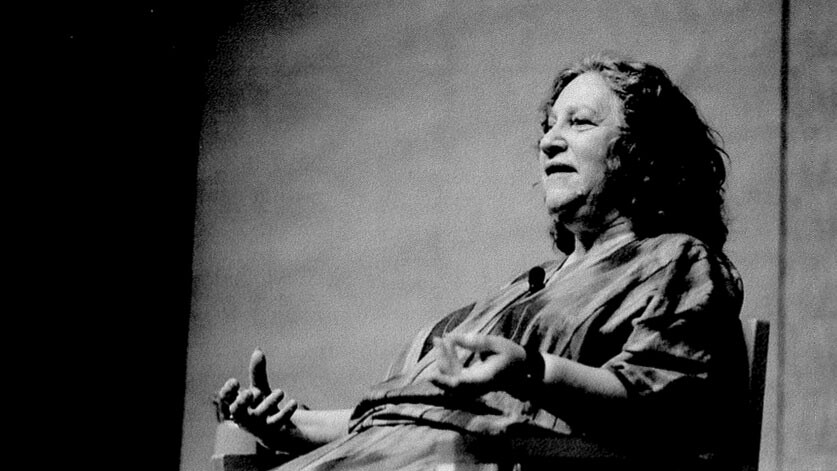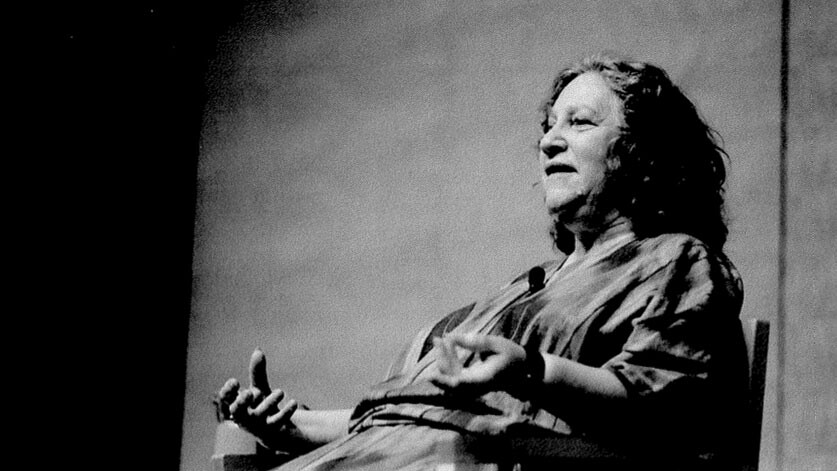

Diane di Prima at her swearing in as San Francisco Poet Laureate, 2010. © Steve Wilson. (Via KQED.)
I remember that I came to San Francisco in 1978 and hooked up with my best friend Sheppard Powell, who was living in the Castro. Diane had just returned to San Francisco from Marshall in Marin County, with her four kids. Allen Ginsberg had introduced Sheppard to Diane.
When Sheppard told me that he had fallen in love with Diane, I told him I didn’t think it would work out, because of the age difference (we were in our twenties and Diane was forty-four). I was twenty-five at the time, and considered myself very wise in the ways of love. I wasn’t. Diane and Sheppard were together for the next forty-two years, falling in love over and over again.
I became part of the Di Prima inner circle. Diane built a community, person by person, day by day. She took friendship very seriously. She was also a great teacher, formally and, mostly, informally. She attracted and was attracted to renegades and radicals, and part of what she taught us was how to survive and even thrive on the edges, at the margins.
She did it all with love, but she was tough. She expected people to be as committed as she was, and if they weren’t, look out. She was like a spiritual drill sergeant. And she was like the Marines: “No worse enemy; no better friend.”
I don’t remember Diane and I having a lasting argument or fight about anything, ever. I knew that she would back me up in any situation, no matter how dire, and she knew I’d do the same for her, and that bound us, in some weird Sicilian-Kansan pact. It’s how we initially understood each other, and that never waned.
I remember harboring various fugitives [from the Brotherhood of Eternal Love, the Hippie Mafia] in our apartment on 16th Street—some political, some drug related, and some a combination of the two. I remember one time, driving around San Francisco in my big white Buick LeSabre (The Knife), trying to stay away from a Sicilian smuggler with a sawed-off shotgun who was out looking for us.
I remember Diane coming into Gret’s hospital room after the Sufi junkie smashed his car into a tree and shattered Gret’s ankle, and Diane putting gemstones and sigils all over her. She then set Gret up with all the best healers in the Bay Area, including Dr. Bone-e, the homeopath, Ian Grand the bodyworker, Greg Schelkun, the hands-on healer, Helen Palmer, the psychic, and Charles Poncé, the Jungian dream analyst, in addition to Sheppard.
I remember that she helped Gret and me to find ourselves and then let us think we’d done it ourselves.
I remember going to a Bob Dylan concert and being charged to take care of Diane’s son Rudi, who was probably eight or nine years old at the time. Rudi ate something at the concert that didn’t agree with him and got sick. I had licked Diane’s famous “orange brick” of Owsley acid earlier that day, and so was peaking when Rudi began to get sick. Nevertheless, I did take care of him and kept him safe, somehow, and I always thought this was excellent preparation for taking care of my own child, later. If you can do it when you’re hallucinating, you can do it any time.
I remember that Diane introduced me to Michael McClure because he and I were both from Kansas, and we immediately hit it off, and Michael taught me the names of all the wildflowers on Mt. Tamalpais. Diane first came to San Francisco in 1961, to visit Michael.
I remember that Diane introduced me to Philip Whalen, who encouraged me to print my first book of poetry, which Diane published under her Eidolon Editions imprint.
I remember when Diane’s daughter Dominique (we called her Mini then) first performed on stage at Mabuhay Gardens, and I knew she was going to be a star. And I remember Mini giving me the manuscript of a play she’d written to give to her father, Amiri Baraka, in Alphabet City, near where my daughter Maya now lives.
I remember the long drives (with me driving Diane’s rattletrap little red death car) from San Francisco in the north to Desert Hot Springs in the south, during one specific period of time, talking with Diane for hours and getting closer than we’d ever been.
I remember one Christmas morning at Diane’s place on Page Street, across from the Zen Center, when Robert Duncan came for a visit. We all sat down at the kitchen table, and Duncan and Diane began to talk. As they talked, Duncan started taking and eating bits from a chunk of hash that was lying in the center of the table. In a couple of hours, he had eaten much of the chunk of hash, but he never stopped talking. That Christmas morning was the first time I had heard of Duncan and Diane’s plans to start a school for poets, “to teach the children of the poor.”
The Poetics Program was built on the affinity of the poets who came together to teach there, and Diane was a big part of that. She taught something called “Hidden Religions,” about the histories of spiritual and political heresies and hermetic traditions in poetry.
I remember that Diane refused to teach her class in the Poetics Program in the old mortuary building where the New College was housed on Valencia Street because she said it had an unhealthy miasma lying over it, so we met at her place on Page Street. And soon after that, a number of faculty members and students in the program all came down with various mysterious ailments.
I remember that Diane was always able to write very directly about complex things, and say and write true things, without pretense or cant, both in poetry and prose, and that’s what drew me to her writing, and it still does.
I remember that Diane bridged many different parts of the radical American poetry tradition. She was really the connection among all these strands of the Romantic Tradition, of the lyric and vatic strains:
From Shelley, Keats and Blake to
Pound, Olson, HD, Duncan, Creeley, Frank O’Hara, Amiri Baraka, Audre Lorde, David Henderson, John Weiners, Phil Whalen, David Meltzer, Duncan McNaughton, Gerrit Lansing, Robert Kelly …
Ginsberg, Waldman, Corso, McClure …
And then, as fate would have it, she ended up in San Francisco during the Poetry Wars and the anti-Romantic backlash. She never played footsie with the counterrevolutionary forces, because she knew what the stakes were. She was a fierce champion of the imagination, which she considered to be under constant attack in our time. She said:
“The war that matters is the war against the imagination—all other wars are subsumed in it.”
—Diane di Prima (1935–2020)
